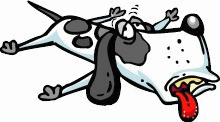|
Your puffy-looking,
sluggish dog may have a thyroid problem.
Hypothyroidism is caused by a thyroid hormone deficiency in the body.
People suffering from low thyroid levels may feel sluggish or gain weight
easily. The same holds true in dogs. But affected pets may display other
symptoms because the thyroid hormone, known as thyroxine, affects just
about every organ in the body.
Hypothyroidism most often occurs when a dog's immune system destroys
its thyroid gland, which is located just below the throat. This condition
is called autoimmune hypothyroidism. In other dogs, the thyroid gland
wastes away, and the cause is unknown. Occasionally, hypothyroidism
is present at birth and leads to a form of dwarfism.
Although hypothyroidism is rare in cats, the symptoms resemble those
seen in dogs. In a few cases, hypothyroidism occurs in cats treated
for an overactive thyroid (hyperthyroidism). Cats rarely have the form
of hypothyroidism that leads to dwarfism.
Risk Factors and Detection
Middle-aged dogs are at higher risk for autoimmune hypothyroidism, and
females are twice as susceptible. Breeds that are predisposed to this
condition include Golden Retrievers, Cocker Spaniels, Labrador retrievers,
Doberman Pinschers, Miniature Schnauzers, Irish Setters, Poodles, Dachshunds,
Boxers, Great Danes, Shetland Sheepdogs, chows, Bulldogs, Airedales,
Pomeranians, and Old English Sheepdogs.
No particular breed or gender is linked to the rare congenital form
of hypothyroidism, which prevents normal development. Affected dogs
are much smaller than their littermates, have large heads and short
legs, and usually maintain their puppy hair coat. Avoid breeding dogs
who have any form of hypothyroidism because the condition may be hereditary.
|
|
|
Signs of hypothyroidism include the following:
-
weight
gain without an appetite increase
-
lethargy
-
fatigues
easily - will run and play hard for a short period of time and then
is either asleep or resting when his littermates or other dogs are
still playing
-
Inconstant
Bowel Movements - dog can exhibit prolonged diarrhoea, or prolonged
constipation, or erratically bouncing between constipated or diarrheic;
never achieving "normal.
-
hair
loss - usually starting at the back of the ears, can also appear
under the throat and down the thighs
-
mottled
coat - hair thin over ribs, normal down backbone and shoulders,
thin under the neck and belly.
-
dry, brittle hair-coat
-
dark or flaky skin
-
excessive skin pigmentation
- spots on the groin or belly, spots can be light or dark
-
recurrent ear or skin infections (the latter can be itchy in some
cases)
-
reproductive problems in unspayed females, such as absent or irregular
heat cycles
-
infertility
- in bitches can cause only a few eggs to be released resulting
in small litters; in dogs can cause low sperm count again resulting
in small litters, or can cause total sterility in either sex.
-
reduced
sex drive - males can show little to no interest in receptive bitches
-
nerve and muscle abnormalities, such as facial paralysis
-
voice change
-
vomiting
-
knuckling
under of the toes or dragging of the feet
-
climatic
sensitivity - dog exhibits discomfort from temperature extremes
As you can see, the
symptoms vary. Not all of these signs must be present, and any of these
symptoms could be caused by other conditions. How's that for confusing?
To diagnose the condition, your veterinarian will perform a thorough
physical examination of your pet. The doctor may discover subtle problems
you didn't notice, including a low heart rate, a low body temperature,
dry eyes, deposits in the cornea, or slowed reflexes.
Your veterinarian will also consider other conditions that may cause
similar symptoms. Some examples: Cushing's syndrome (hyperadrenocorticism)
or sex hormone tumours may cause bilateral, non-itchy hair loss. Addison's
disease (hypoadrenocorticism) or a heart abnormality may cause a slowed
heart rate, lethargy, and weakness.
As part of a complete examination, the doctor also will take a sample
of your dog's blood to test the levels of thyroxine (T4) and thyroid
stimulating hormone (TSH). Abnormalities may include a low T4 level,
a high TSH level, mild anaemia, and a high cholesterol level. Your veterinarian
will also rule out concurrent problems that falsely lower a dog's thyroxine
level.

Prevention and Treatment
There is no known prevention for hypothyroidism, but treatment generally
produces positive results. Dogs receive thyroid supplementation (synthetic
L-thyroxine) in pill form, usually twice a day for life. Your veterinarian
will probably take a blood sample six to eight hours after the first
dose.
If the dose is too high, signs of hyperthyroidism such as panting, nervousness,
increased thirst and urination, and increased appetite can occur. These
symptoms resolve quickly once the doctor adjusts the dose.
Your veterinarian will monitor your dog's thyroxine level periodically
- usually within six to eight weeks after starting therapy, again a
few weeks after making any dose changes, and once or twice a year to
ensure the dose is adequate.
Your dog's energy will return about a week after treatment begins. You'll
notice improved skin and weight loss in four to eight weeks, and hair
will regrow fully in several months. Pets treated for hypothyroidism
typically live a normal life with continued therapy.
:: Diseases :: Health
::

|
|


